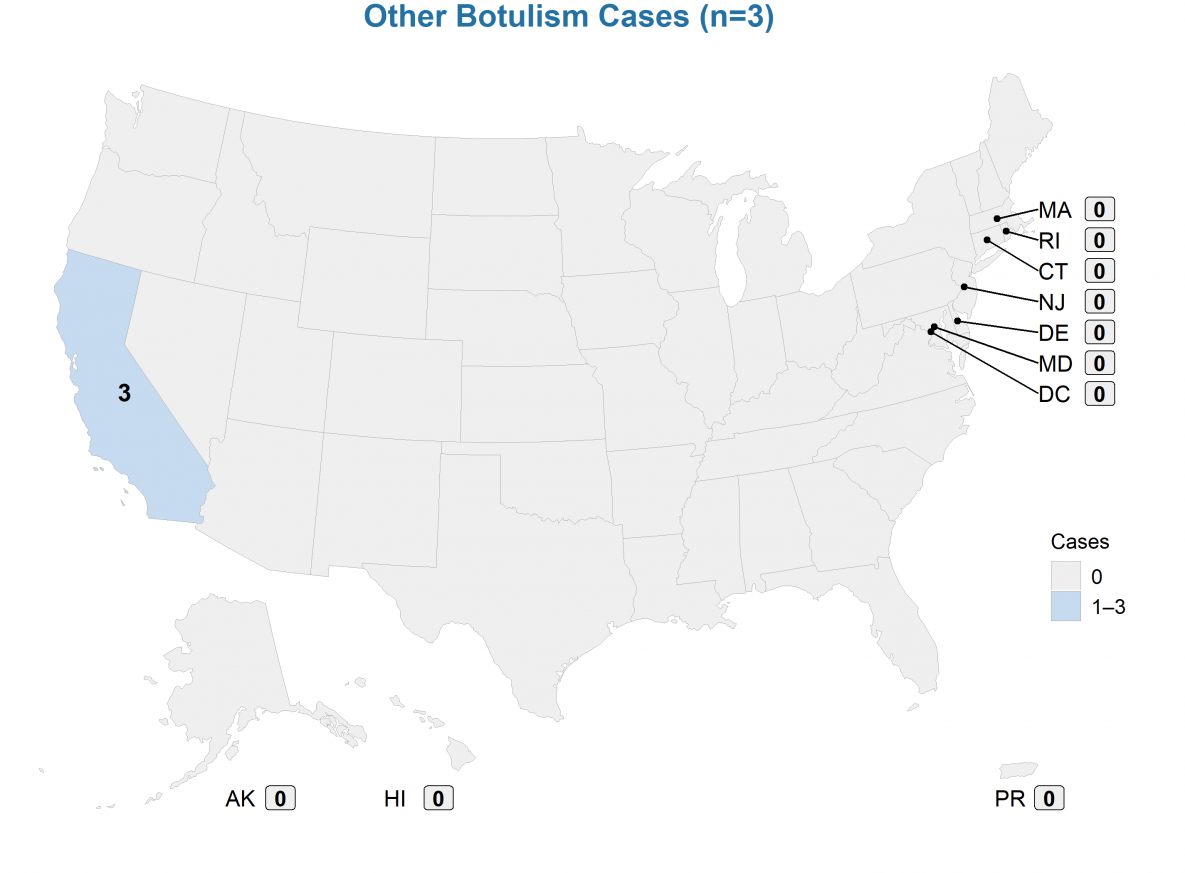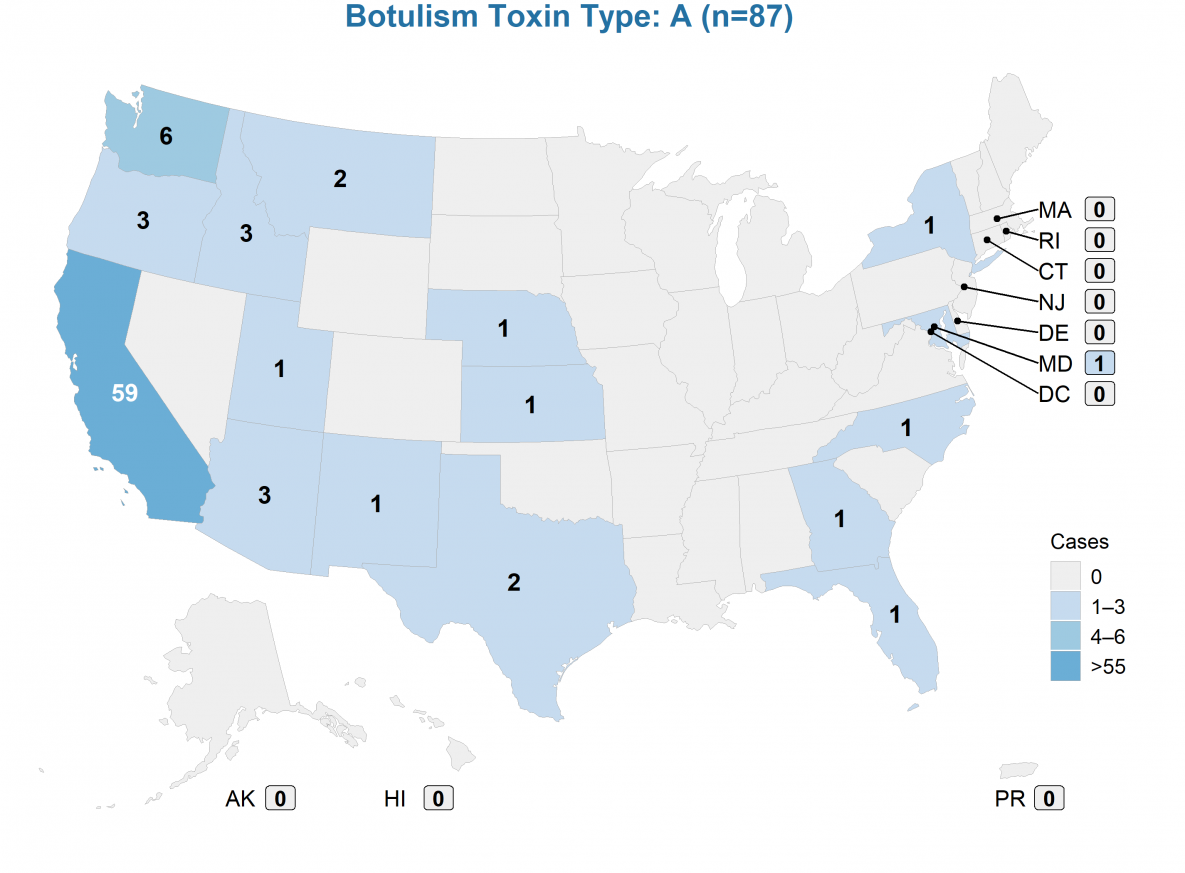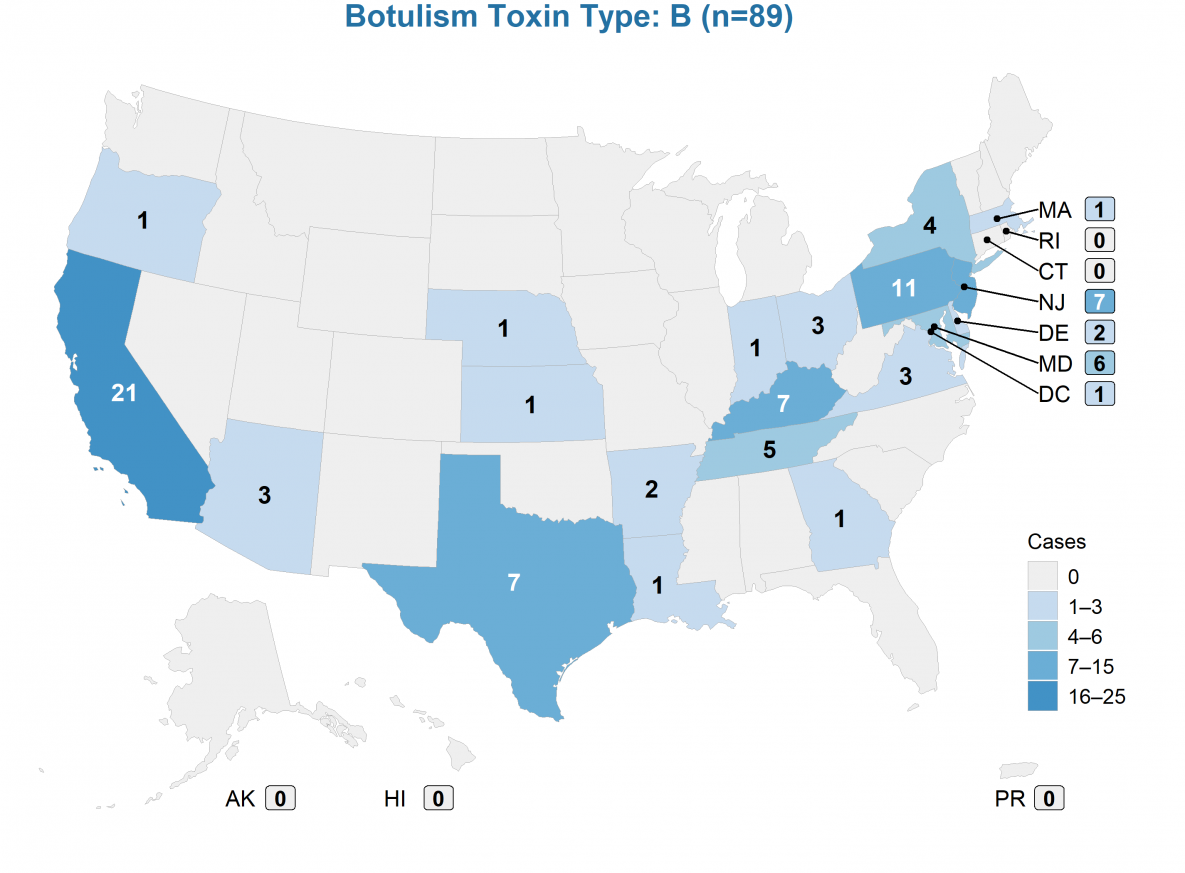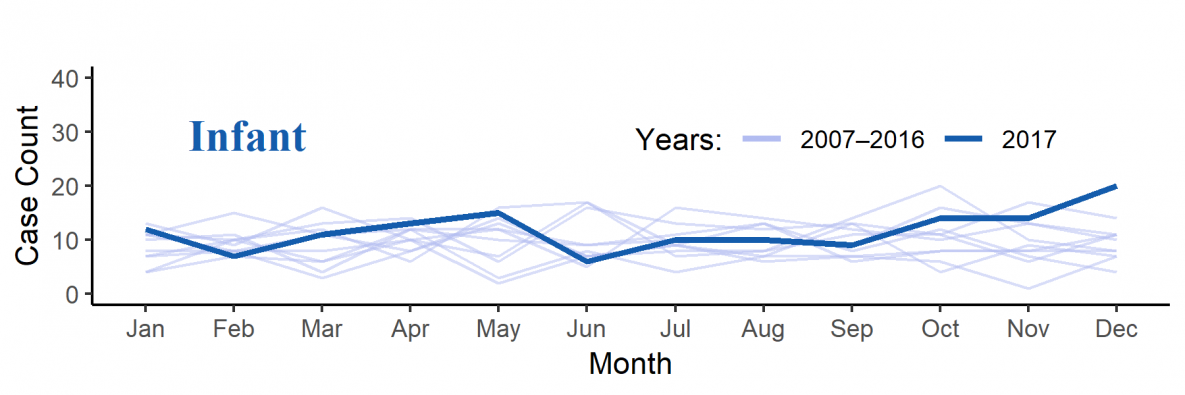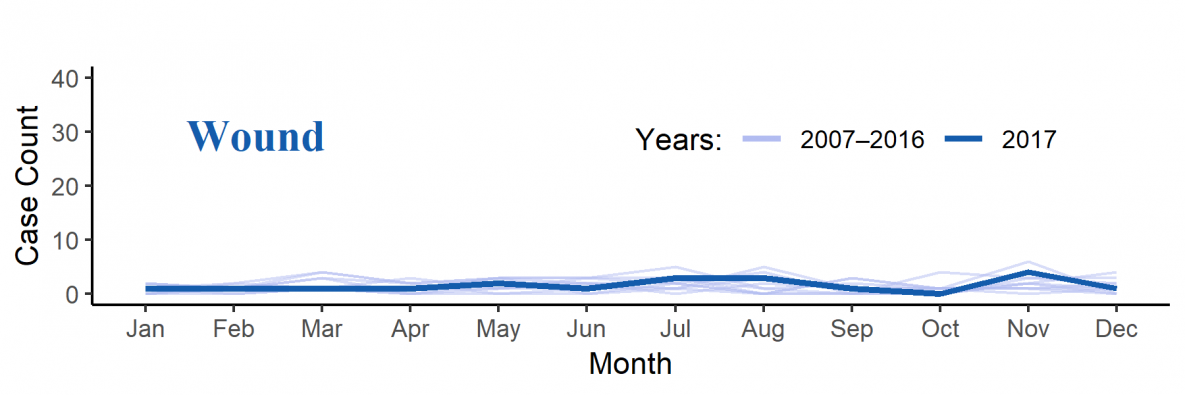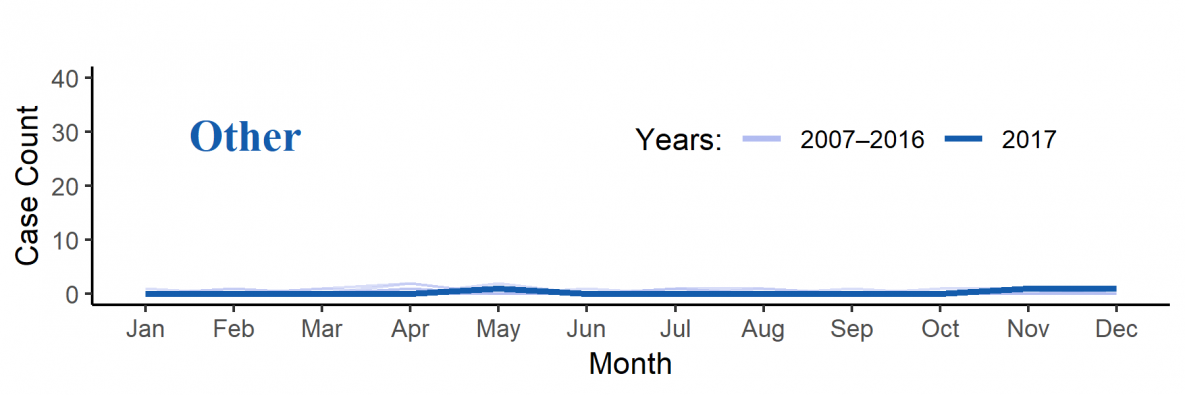National Botulism Surveillance Summary, 2017
In 2017, 182 laboratory-confirmed botulism cases were reported to CDC—141 (77%) infant, 19 (10%) foodborne, 19 (10%) wound, and three (1%) “other” classified as: two (1%) iatrogenic, and one (1%) suspected adult intestinal colonization (Table 1).
Infant botulism cases were reported from 26 states and the District of Columbia, with California reporting the most (n=48, 34%). Toxin types were A (n=52, 37%), B (n=88, 62%), and Ba (n=1, 1%). The median age of infants was four months (range: 0–12 months); 72 (51%) were girls. No deaths were reported.
Foodborne botulism cases were reported from California (n=15) and Alaska (n=4). Among the 15 toxin type A foodborne botulism cases in California, 10 were from an outbreak linked to nacho cheese at a convenience store, two were from an outbreak linked to an herbal deer antler tea, one was from a suspected soup with bulging lid but was not available testing, and two were not linked to a known food source. (1) Among the four toxin type E foodborne botulism cases in Alaska, three were from an outbreak linked to seal blubber with seal oil, and one was linked to dried herring in seal oil (Table 2a). The median age of patients was 42 years (range: 14–85 years); 11 were men. Three deaths were reported.
Two probable foodborne botulism cases* were reported from Alaska. They occurred in one household among women 29 and 54 years old who ate fermented white fish. (Table 2b). No deaths were reported.
Nineteen wound botulism cases were reported from four states—16 from California, and one each from Arizona, New Mexico, and Washington. Seventeen were among persons who inject drugs, one was linked to injuries from an all-terrain vehicle crash, and one was from an arm fracture contaminated with soil. Most were toxin type A (n=18); the presence of toxin was confirmed in one patient’s blood but there was not enough blood to determine the toxin type. The median age of patients was 48 years (range: 14–71 years); 15 were men. No deaths were reported.
Eleven probable wound botulism cases† were reported from six states. Ten were among persons who inject drugs and one case was in a child who had a wound. The median age of patients was 39 years (range: 10–63 years). Five patients were male; no deaths were reported.
California reported two iatrogenic cases—one was toxin type A, and one was toxin type B. No deaths were reported. California also reported one patient with toxin type A and suspected adult intestinal colonization who died.
* Clinically compatible illness, not laboratory-confirmed, with an epidemiologic link to a food or drink suspected to be contaminated with botulinum toxin.
† Clinically compatible case with no suspected exposure to contaminated food and with a history in the 2 weeks before illness began of either a fresh wound or injection drug use.
| Transmission Category | Cases | Median Age (range) |
Deaths | Sex, male n (%) / female n (%) |
Toxin Type, n (%) type |
Exposures, n (%) type |
Outbreaks* |
|---|---|---|---|---|---|---|---|
| Infant | 141 | 4 (0–12) months | 0 | 69 (49) / 72 (51) | 52 (37) A, 88 (62) B, 1 (1) Ba |
N/A | 0 |
| Foodborne | 19 | 42 (14–85) years | 3 | 11 (58) / 8 (42) | 15 (79) A, 4 (21) E | See Table 2a | 3 |
| Wound | 19 | 48 (14–71) years | 0 | 15 (70) / 4 (21) | 18 (95) A, 1 (5) A/B/E‡ | 17 (89) IDU§ | 0 |
| Other** | 3 | 43 (31–80) years | 1 | 1 (33) / 2 (67) | 2 (67) A, 1 (33) B |
N/A | 0 |
| Transmission Category | Cases | Median Age (range) |
Deaths | Sex, male n (%) / female n (%) |
Toxin Type, n (%) type |
Exposures, n (%) type |
Outbreaks* |
|---|---|---|---|---|---|---|---|
| Foodborne† | 2 | 42 (29–54) years | 0 | 0 (0) / 2 (100) | N/A | See Table 2b | 1 |
| Wound¶ | 11 | 39 (10–63) years | 0 | 5 (45) / 6 (55) | N/A | 10 (91) IDU§ | 0 |
* Outbreak defined as two or more cases resulting from a common exposure.
† Probable foodborne botulism is a clinically compatible case with an epidemiologic link (e.g., ingestion of a home-canned food within the previous 48 hours).
‡ Confirmed presence of toxin, but toxin type was indeterminate.
§ IDU: injection drug use.
¶ Probable wound botulism is a clinically compatible case with no suspected exposure to contaminated food and with a history in the 2 weeks before illness began of either a fresh contaminated wound or injection drug use.
** “Other” includes adult intestinal colonization, iatrogenic botulism, and unknown routes of transmission.
| Month | State | Confirmed or Suspected Food | Toxin Type | Number of Cases |
|---|---|---|---|---|
| February | California | Unknown† | A | 1 |
| April | California | Herbal deer antler tea | A | 2 |
| April-May | California | Nacho cheese* | A | 10 |
| April | California | Soup with bulging lid | A | 1 |
| August | Alaska | Dried herring in seal oil | E | 1 |
| August | Alaska | Seal blubber with seal oil* | E | 3 |
| September | California | Unknown‡ | A | 1 |
* Foods followed by an asterisk were confirmed as the source by detection of toxin in food. In foods without an asterisk, toxin was not detected or food item was not available for testing; food vehicle was suspected based on clinical history, epidemiological evidence, or reported method of preparation or storage.
† There were no suspected food items available to test as the trash had already been removed.
‡ Potentially unsafe food maintenance practices were observed.
Figure 1. Laboratory-Confirmed Botulism Cases by State or Territory and Transmission Category—United States, 2017
Figure 2. Laboratory-confirmed botulism cases by state/territory and toxin type—United States, 2017
Figure 3. Confirmed botulism cases by month of onset and transmission category—United States, 2007−2017

Ohio outbreak associated with home-canned potatoes, 2015, 27 confirmed cases (2)
Mississippi outbreak linked to prison-made illicit alcohol, 2016, 19 confirmed cases (3)
California outbreak linked to nacho cheese sauce, 2017, 10 confirmed cases (4)
- Kim M, Zahn M, Reporter R, Askar Z, Green N, Needham M, Rosen H, Kimura A, Terashita D. Outbreak of Foodborne Botulism Associated With Prepackaged Pouches of Liquid Herbal Tea. Open Forum Infect Dis. 2019 Feb;6(2):ofz014. DOI PubMed
- McCarty CL, Angelo K, Beer KD, Cibulskas-White K, Quinn K, de Fijter S, Bokanyi R, St Germain E, Baransi K, Barlow K, et al. Large Outbreak of Botulism Associated with a Church Potluck Meal—Ohio, 2015. MMWR Morb Mortal Wkly Rep. 2015 Jul 31;64(29):802–3. PubMed
- McCrickard L, Marlow M, Self JL, Watkins LF, Chatham-Stephens K, Anderson J, Hand S, Taylor K, Hanson J, Patrick K, et al. Notes from the Field: Botulism Outbreak from Drinking Prison-Made Illicit Alcohol in a Federal Correctional Facility – Mississippi, June 2016. MMWR Morb Mortal Wkly Rep. 2017 Jan 6;65(52):1491–2. PubMed
- CDPH Testing Confirms Botulism Linked to Nacho Cheese Sauce Sold at Sacramento County Gas Station. 2017 [cited 2018 11/13]; Available from: https://www.cdph.ca.gov/Programs/OPA/Pages/NR17-047.aspx
Centers for Disease Control and Prevention (CDC). Botulism Annual Summary, 2017. Atlanta, Georgia: U.S. Department of Health and Human Services, CDC, 2019.




